Is Fantom (FTM) Yet Another Ethereum Killer?
In this section, I’m going to answer the question of “What is Fantom crypto?” and tell you about the Fantom ecosystem projects!
So, what is Fantom (FTM), and why should you pay attention? Whether you're a crypto enthusiast or new to the space, Fantom's name is something that you better be aware of. Cause it’s like a real phantom. If you’re oblivious about its existence, you won’t see how much you could be missing out!
Yet, Fantom is more than just a cryptocurrency. It encompasses an entire DeFi ecosystem, and introduces unique ways of solving universal blockchain problems. Learning about Fantom (FTM) can be beneficial for those interested in exploring the innovative blockchain technology and its potential applications. By understanding Fantom's unique approach to scalability and its focus on high-speed transaction processing, you’ll get a new perspective on what is what when it comes to blockchains!
In this section, we’re going to answer the questions from “What is Fantom crypto?” to “What is FTM crypto?” and then, having established clear definitions of these key concepts, we’ll take a look at Fantom ecosystem projects and how important they are.
Now, let’s get straight to the point!

Video Explainer
Video Explainer: Is Fantom (FTM) Yet Another Ethereum Killer?
Reading is not your thing? Watch the "Is Fantom (FTM) Yet Another Ethereum Killer?" video explainer
What is Fantom? | Animated FTM Explainer
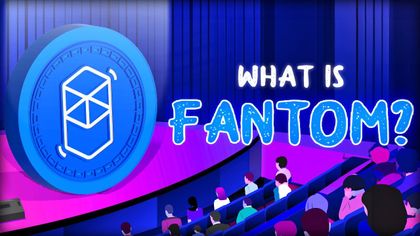

What is Fantom in Crypto?
So, let’s begin by answering the question, “What is Fantom crypto?”. First and foremost, Fantom is a blockchain network. It was developed by a team led by Dr. Ahn Byung Ik, a computer scientist and entrepreneur. The project began in 2018 under the guidance of Fantom Foundation, a non-profit organization headquartered in South Korea.
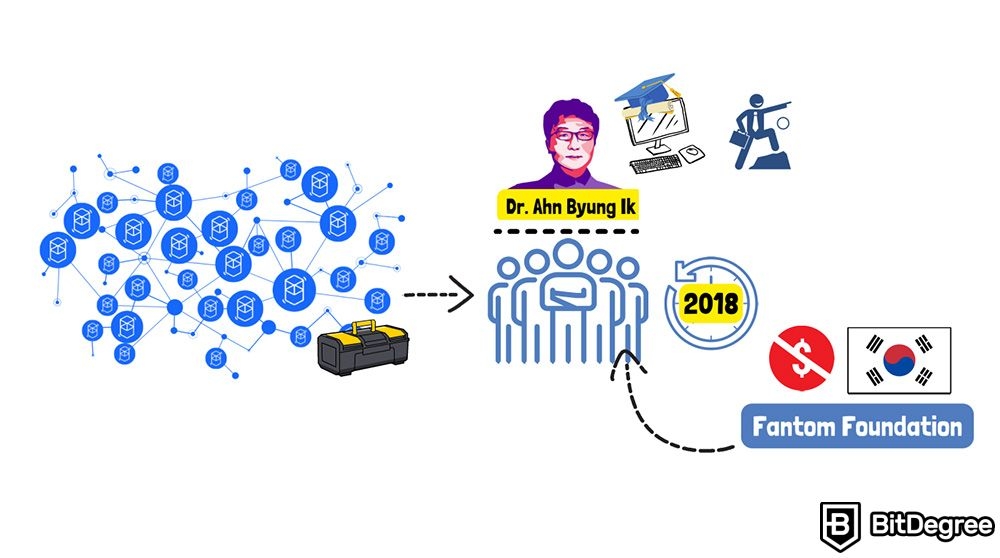
As always, a new, promising project is launched only when the team behind it feels like they can offer something that other, current market players cannot. So, the motivation behind creating Fantom was to overcome the limitations of existing blockchain platforms.
The team sought to build a secure and scalable infrastructure capable of handling high-speed transactions and supporting large-scale decentralized applications across various industries. Well, this sounds like something that literally every blockchain out there claims to have as its goal. But here’s what makes Fantom different.
To achieve this, Fantom incorporated an innovative technology known as Lachesis and made it the network’s consensus mechanism. Without going into details, a consensus mechanism is an engine that implements a set of rules that power the blockchain and ensure its smooth functioning.
The Lachesis technology enables rapid transaction processing and scalability, as its output can be used immediately. There is no need to wait for block confirmations, because transactions are confirmed in 1-2 seconds.
Think of it as WhatsApp. It made communication between people way faster than it was before the existence of this app. So, Lachesis does the same thing, but to on-chain transactions.
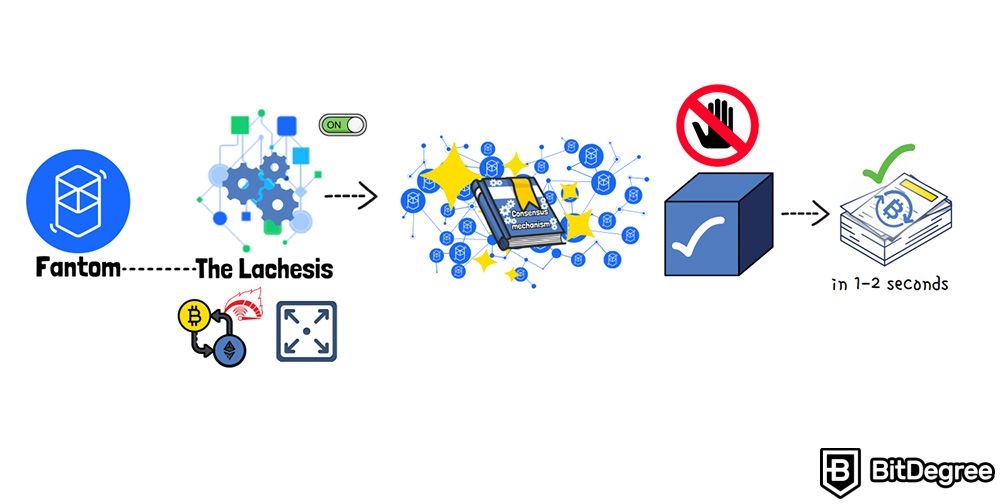
Additionally, the platform implemented something called the Byzantine Fault-Tolerant (BFT) mechanism. Now that’s something to be aware of when it comes to understanding blockchain networks consisting of many participants.
Byzantine Fault-Tolerant is a term used to describe a system's ability to function correctly and reach a consensus even when some components of the system are faulty or behave maliciously.
For example, imagine a group of friends trying to decide on where they will all go out for lunch. They need to agree on the final choice, but there's a catch: some friends may intentionally give ironic answers or joke about going to such places as Krusty Burger. Despite such disruptions, a final consensus will have to be reached.
Byzantine Fault-Tolerance is like having a trustworthy friend in the group who can identify, cut through the irony and nonsense, and, as a result, filter out the misleading information and ensure everyone reaches a reliable decision. This friend's role is to ensure that even if a few friends are trying to disrupt the decision-making process, the group can still come to a consensus that everyone can trust.
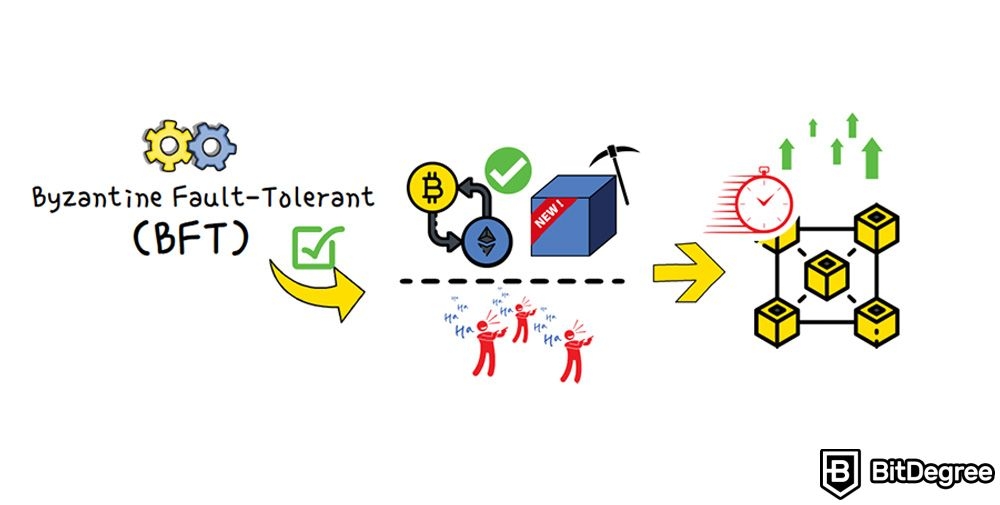
When it comes to serious matters like transaction verification and new block creation, such obstacles must be overcome, and the Byzantine Fault-Tolerance mechanism is a tool to achieve this, thus increasing the blockchain’s speed and operational efficiency.
There’s something else about Fantom that has to be addressed, though. The fact that the team behind it ensured the blockchain’s compatibility with Ethereum, allowing seamless integration with Ethereum-based applications. Keeping in mind how buzzing the Ethereum ecosystem is, such a feature is like creating a visa-free border system between two neighboring countries.
Fantom quickly gained attention and support from the cryptocurrency community and industry partners. Therefore, it’s no surprise that the list of its strategic partnerships has many notable, prominent, and industry-established names on it. This makes sense, since, from its very inception, the Fantom team has been actively developing the platform, expanding its ecosystem, and driving adoption.
All of this sounds like a serious deal. And, the more people saw this, the more attention the Fantom project received. As it’s usually the case, positive attention was reflected in FTM’s, its native cryptocurrency’s, value increasing. FTM plays a crucial role in powering the Fantom network and incentivizing participants.
Let’s look into it in more detail.
What is FTM in Crypto?
Even though FTM sounds like just an abbreviation for Fantom, it would be a mistake to think that it’s the same thing. FTM is a cryptocurrency, and, as said earlier, it’s native to the Fantom blockchain network.
FTM is a utility token, which means that it’s used for payments, network fees, staking, and governance. Thus, it plays a central role in transactions, fee collection, staking activities, and user rewards.
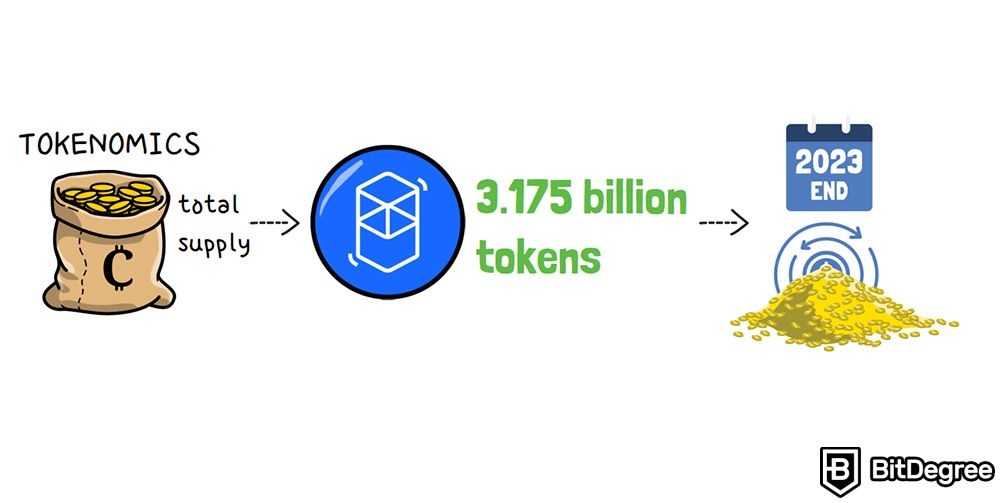
When it comes down to tokenomics, the total supply of FTM is 3.175 billion tokens. By the end of 2023, all of these tokens will be released into circulation.
The gradual release of tokens was carefully thought through during the design process, and, as a result, a significant portion of the entire supply was reserved for staking rewards for those users who have chosen to stake their FTM holdings.
Think of it as all the interest that you’d receive if you put aside your savings into a savings account at a retail bank. The bank system is structured to reward depositors for keeping their money within the said institution. When it comes to staking and crypto tech, these staking reward reserves have to be meticulously calculated and locked, so they could be released when the time to issue staking rewards comes.
By the way, if you feel like your knowledge about staking could be refreshed, don’t hesitate and check out this section!
Fantom Ecosystem Projects
Moving on with this “What is Fantom crypto?” section, it’s time to address yet another reason behind this blockchain’s popularity and importance – Fantom ecosystem projects. And there are plenty of those. But what’s the reason for that? The answer is… Opera.
Fantom Opera is the main deployment platform of the Fantom (FTM) blockchain. It is a decentralized and permissionless application development layer that supports the operation of decentralized applications (dApps) on the Fantom network. Opera is designed to provide a seamless environment for developers to create and deploy smart contracts using Fantom's unique features.
To put it simply, the Fantom network is like a city, and Fantom Opera is like its downtown, full of hip offices, workshops, and opportunities. Smart and productive people get there to make their ideas come to life. When it comes to blockchain, these ideas are dApps, and thanks to Opera, creators and developers get the necessary tools and environments to work on them.
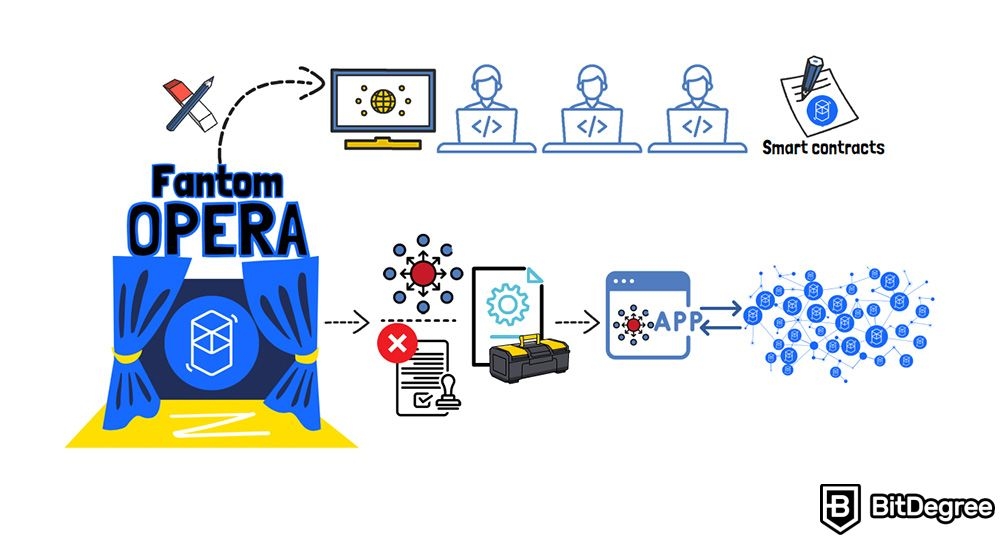
One of the key aspects of Fantom Opera is its compatibility with the Ethereum Virtual Machine (EVM) and support for the Solidity programming language. Such a feature allows developers to leverage their existing knowledge and experience with Ethereum to build and deploy dApps on the Fantom network. So, Fantom enables developers to easily port their Ethereum-based projects to the Fantom ecosystem.
Think of this as the Brooklyn Bridge. Manhattan locals can easily reach Brooklynittes, and vice versa. This enables fast and effective exchange of information, ideas, experience, and everything in between. So this connection between Fantom and Ethereum does exactly that, just in blockchain terms.
Therefore, the list of Fantom ecosystem projects has such names as Sushiswap, Beefy, and similar ones, including over 250 NFT projects. For an ecosystem that’s relatively young, these are fascinating numbers.
Of course, it’s easy to talk about dApps when you understand them. But if you don’t, no worries, I’ve covered them in a separate section - check it out!
Wrapping Up
That's it, now you know “What is Fantom crypto?”, “What is FTM crypto?”, and all about the landscape of Fantom ecosystem projects.
Overall, it can be concluded that Fantom was created to address the scalability and security challenges faced by existing competitor blockchains, and to provide an effective, robust infrastructure for dApps. In order to achieve this, the Fantom team created FTM, Fantom’s native utility token, and found novelty solutions for making the whole structure more solid, efficient, and scalable.















